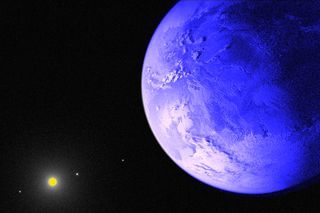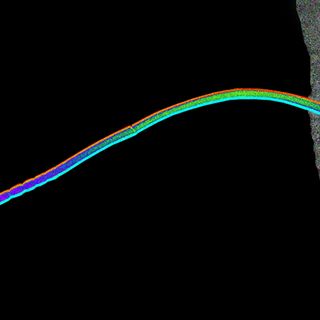
Alien Worlds That May Be Habitable for Billions of Years May Look Nothing Like Earth
“..our Earth-centered idea of a life-friendly planet might be too narrow,” the researchers said.

Earth is quite extraordinary: it is the only place in the entirety of the cosmos (that we know of) where life has emerged with certainty. So naturally, when scientists think of habitable exoplanets, the traditional instinct is to look for those that have similar habitability conditions. Chief among those conditions is the prerequisite for liquid water — because the traditional understanding goes that where there is water, there is potential for life.
There is an important question to be asked here: What if there is evidence of long-term liquid water on alien planets that look nothing like Earth? New research, led by astronomer Marit Mol Lous of the University of Zürich in Switzerland, shows that conditions for life may not always replicate Earth’s atmosphere. They have identified an exoplanet, a “super-Earth exoplanet,” if you will, one that is more massive than Earth but measures less in size than Neptune.
Published in the journal Natureon Monday, the study shows that “favorable conditions might even occur for billions of years on planets that barely resemble our home planet at all.” The exoplanets look nothing like Earth by virtue of atmospheric differences. While they have a blanket of hydrogen and helium, Earth’s atmosphere consists of nitrogen and oxygen, with only some traces of hydrogen and helium.
The science involves understanding water, atmosphere, and life. “One of the reasons that water can be liquid on Earth is its atmosphere. With its natural greenhouse effect, it traps just the right amount of heat to create the right conditions for oceans, rivers, and rain,” said theoretical astrophysicist Ravit Helled of the University of Zurich in Switzerland in a press release.
Our atmosphere didn’t always exist as a blanket of sustaining life though. Right now, nitrogen and oxygen dominate, but that wasn’t always the case. Helium and hydrogen were part of the early days of Earth, remnants of the dust and gas left when the Sun and the Solar System formed. This is what is called the “primordial atmosphere.” Earth lost its primordial atmosphere with time; everything from meteorites to the power of a hot, young sun had something to do with it. The atmosphere that has evolved now thus is less reliant on hydrogen and helium.
Related on The Swaddle:
Earth‑Like, Potentially Habitable Planet Discovered 102 Light Years Away
“Such massive primordial atmospheres can also induce a greenhouse effect — much like Earth’s atmosphere today. We, therefore, wanted to find out if these atmospheres can help to create the necessary conditions for liquid water,” Helled said.
In experiments, scientists modeled different versions of exoplanets and traced their evolution, accounting for the planets’ atmosphere, the intensity of their stars’ radiation, and the planets’ internal heat that radiates outside. “Astronomers typically expect liquid water to occur in regions around stars that receive just the right amount of radiation: not too much, so that the water does not evaporate, and not too little, so that it does not all freeze,” explained study co-author Christoph Mordasini, Professor of Theoretical Astrophysics at the University of Bern and member of the NCCR Planets.
But in these experiments, where the primordial atmosphere remained over a long period of time, water could emerge. In other words, researchers found these exoplanets could still be warm enough to sustain liquid water for as long as 10 billion years. “To many, this may come as a surprise,” added Mordasini.
We can hold back on the optimistic search for more habitable planets though. The research proposes a theory that could expand our idea of newer, sustaining worlds, but a million things have to align in the right order at the right time to create the exact conditions required for water to emerge. For instance, an exoplanet needs to evade the star’s radiation that dries out its primordial atmosphere, and thus must be placed at quite a distance from the star. And a solar system that is far from the sun is also likely to have conditions where any water may only be frozen, not liquid. It is only when an exoplanet is at the right distance from its host star, and has an internal heating mechanism, that it could potentially create conditions for liquid water — and life — to thrive.
What this research does tell us is the current search for habitable planets is restrictive; it gives us “a good argument to keep thinking out-of-the-box when it comes to habitability,” as Mol Lous told Space.com
Mordasini adds: “Since the availability of liquid water is a likely prerequisite for life, and life probably took many millions of years to emerge on Earth, this could greatly expand the horizon for the search for alien lifeforms. Based on our results, it could even emerge on so-called free-floating planets, that do not orbit around a star.”
This calls into question just how much exoplanets have to resemble Earth to sustain life. Scientists have found other alien planets — even other super-Earths (that have up to 10 times Earth’s mass) — but all in other solar systems. These are all planetary bodies different from ours, which almost always weeded out the possibility of habitability. But the current theory goes against what scientists traditionally know and have believed, and can simultaneously prove to be wondrously intriguing.
Saumya Kalia is an Associate Editor at The Swaddle. Her journalism and writing explore issues of social justice, digital sub-cultures, media ecosystem, literature, and memory as they cut across socio-cultural periods. You can reach her at @Saumya_Kalia.
Related


Scientists Discover Eye‑Lash Length Bacteria, the Largest Ever Found
